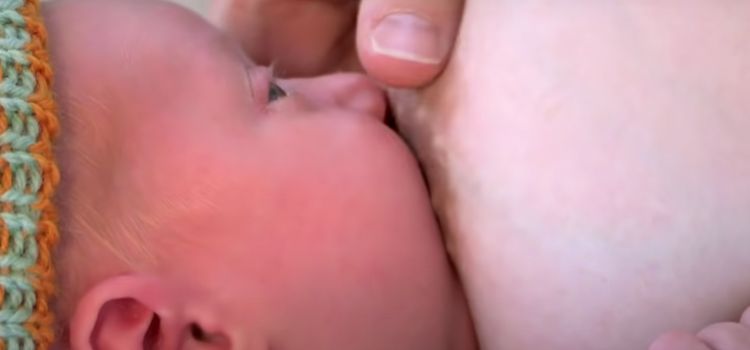As an Amazon Associate I earn from qualifying purchases.
Breastfeeding is a gorgeous and natural experience shared by a mother and her baby. It provides vital sustenance and fosters a strong bond. Nonetheless, parents may observe alterations in their baby’s appearance during breastfeeding. A prevalent observation is a baby’s face turning red. Despite the fact that this may raise concerns, it is essential to keep in mind that each baby is unique and their reactions can vary. This blog post will investigate the question “Why does my baby’s face turn red when breastfeeding?” to cast light on this enthralling phenomenon. So, let’s delve into the intriguing world of breastfeeding and figure out what may be behind this endearing but perplexing phenomenon.

Briefly introduce the topic of why a baby’s face turns red during breastfeeding.
Many parents may ponder why their baby’s face turns red during breastfeeding. This phenomenon is quite prevalent and can be attributed to a variety of causes. When a baby latches onto the breast and begins to feed, their facial muscles function in conjunction with their suckling reflex, resulting in increased blood flow to the face. This may cause a reddening of the skin. In addition, the physical exertion of breastfeeding can temporarily increase a baby’s pulse rate, which contributes to discoloration. Despite the fact that this discoloration is typically innocuous and normal, it is always prudent to consult a healthcare professional if you are concerned about the health of your baby while breastfeeding.
Highlight the importance of understanding this phenomenon for new parents.
New parents must understand why a baby’s face turns red during breastfeeding. This phenomenon, referred to as “blushing baby syndrome,” is a normal reaction caused by increased blood flow to the face during suckling. By understanding this process, parents can alleviate unwarranted anxiety and concern. In addition, understanding this phenomenon enables parents to identify any potential problems or distress their baby may be experiencing while breastfeeding. Therefore, it is essential for new parents to comprehend why a baby’s face turns red during breastfeeding in order to ensure the baby’s health and promote a positive nursing experience.
Understanding the Physiology:
Explain the normal physiological changes that occur during breastfeeding.
Both the mother and the baby go through a number of normal physiological changes while breastfeeding. A common observation during breastfeeding is that a baby’s face may turn red. This occurs as a result of the increased blood flow and circulation to the face caused by the baby’s vigorous sucking and swallowing of breast milk. Usually, the discoloration is temporary and should not cause concern. It is a natural response that indicates the baby is actively engaged in suckling and receiving adequate nutrition.
Discuss how the baby’s body responds to the stimulation of breastfeeding.
It is common for a baby’s face to turn red during breastfeeding as their body responds to the stimulation. This is a normal response caused by an increase in blood flow to the face. The suckling motion and stimulation of the nipple cause the release of oxytocin, a hormone that aids in milk production and mother-baby bonding. As the baby latches on to the breast and begins to feed, facial muscles and blood vessels contract, causing the face to blanch and turn red. This physiological response indicates that the baby’s body is actively participating in breastfeeding and receiving the necessary nourishment.
Increased Blood Flow:
Explore the concept of increased blood flow to the baby’s face.
You may observe that your baby’s face turns red while breastfeeding. This is commonly attributed to increased blood supply to the baby’s face. However, why does this occur? During breastfeeding, the increased blood flow to the baby’s face is a natural response to sucking. The suction motion stimulates blood vessels in the face, causing them to dilate, as the baby latches onto the breast and begins to feed. This dilation causes an increase in blood flow, which causes the baby’s face to become red. It is a normal physiological reaction that indicates your baby is actively suckling and receiving nourishment.
Explain why this can cause the baby’s face to turn red.
It is common for a baby’s face to turn red when breastfeeding. This phenomenon may occur for various reasons. First, the effort of inhaling and ingesting can increase blood flow to the face, resulting in a ruddy appearance. In addition, the rapid and vigorous movements of the baby’s facial musculature during suckling may contribute to the discoloration. In addition, some infants may experience a strong discharge reflex, which may result in a forceful milk flow. This may cause the baby to inhale or suffocate, resulting in a transient reddening of the face. The combination of these factors can explain why your baby’s face may turn red while breastfeeding.
Discuss the role of blood vessels and increased oxygenation.
Many parents ponder why their baby’s face turns red while breastfeeding. The solution lies in the function of blood vessels and enhanced oxygenation. The suckling action stimulates blood flow to the face when a baby attaches to the breast and begins nursing. This increased blood flow causes the face’s blood vessels to dilate, resulting in a reddening of the epidermis. While breastfeeding, the baby’s body works to deliver more oxygen to the muscles and tissues involved. This increased oxygenation, in conjunction with the dilation of blood vessels, causes the transient reddening of the baby’s face during breastfeeding.
Hunger and Excitement:
Discuss how hunger and excitement can contribute to a baby’s red face.

Hunger and exhilaration can significantly contribute to a baby’s face turning red during breastfeeding. When a baby is famished, they tend to become more enthusiastic and anxious during feeding. This elevated level of exhilaration can result in increased blood flow, causing the baby’s face to become red. Additionally, the act of breastfeeding can be physically demanding for a baby, as sucking and swallowing milk requires effort. This effort may also contribute to their reddened face. Understanding why your baby’s face turns red during breastfeeding will allow you to ensure their comfort and well-being during feedings.
Explain how babies may become more active and alert during breastfeeding.
During breastfeeding, infants may become more active and vigilant due to a variety of factors. The increased blood flow and oxygen supply to the brain as a result of the stimulation of the suckling reflex is one possible explanation. In addition, the release of hormones during breastfeeding, such as oxytocin, can induce feelings of calm and relaxation in both mother and baby. In addition, breastfeeding can provide a comforting and soothing environment for the baby, resulting in increased engagement and responsiveness. During breastfeeding, some infants may experience a transient reddening of the face, which is a normal physiological response and should not cause concern.
Highlight the connection between increased activity and redness.
This erythema is frequently associated with increased feeding activity. The relationship between increased activity and erythema can be attributed to the baby’s effort during breastfeeding. As infants suckle and ingest breast milk, their facial muscles contract, increasing blood flow to the face. This increased blood flow may cause the baby’s face to become temporarily red. It is crucial to make sure the baby is secure and correctly latches during breastfeeding sessions, even though this phenomenon is generally innocuous and typical.
Facial Reflexes:
Explore the concept of facial reflexes during breastfeeding.
Many parents may ponder why their baby’s face turns red during breastfeeding. This phenomenon is explicable in terms of facial reflexes. Facial reflexes are involuntary movements of the face that occur in response to specific stimuli. When a baby latches onto the breast and begins nursing, the stimulation of the suction reflex can increase blood flow to the face, causing a reddening of the epidermis. This is a natural and normal reaction for which there is no cause for concern. Understanding these facial reflexes can help breastfeeding parents feel assured and confident.
Explain how sucking and swallowing motions can contribute to this phenomenon.
It’s common for infants’ features to turn red during breastfeeding. This occurrence results from the suckling and ingesting movements involved in breastfeeding. When a baby holds onto the breast, a vacuum-like suction is created to extract milk. This suction can increase blood flow to the face, leading to a reddened appearance. Additionally, the ingesting motion during breastfeeding can also contribute to discoloration as it activates the muscles in the face. Therefore, the combination of suckling and ingesting motions during breastfeeding can cause a baby’s face to become temporarily red.
When to Seek Medical Advice:
Provide guidance on when parents should seek medical advice regarding their baby’s red face during breastfeeding.
It is crucial to know when to seek medical attention if you find yourself pondering, “Why does my baby’s face turn red during breastfeeding?” Even though a baby’s face turning red during breastfeeding is a common occurrence, it can sometimes indicate a more serious underlying problem. If your baby’s face remains red for an extended period of time, is accompanied by other concerning symptoms such as difficulty breathing or excessive fussiness, or if you observe changes in your baby’s nursing patterns, it is advised that you consult a healthcare professional. They can provide the necessary guidance and ensure your child’s well-being.

Conclusion
In conclusion, the discoloration on your baby’s face that occurs during breastfeeding is quite common and typically not cause for concern. It is predominantly caused by the increased blood flow to the face brought on by the baby’s vigorous suckling and ingesting during feeding. This increased blood flow assists in transporting oxygen and nutrients to their developing bodies. Additionally, some infants may turn red because of their immature circulatory system or the mother’s increased discharge reflex. However, if your baby exhibits signs of distress, difficulty breathing, or if the discoloration persists after feeding, you should consult a pediatrician to rule out underlying issues. Remember that each baby is unique, and if you have any concerns or queries, you should always consult a medical professional.
Amazon and the Amazon logo are trademarks of Amazon.com, Inc, or its affiliates.